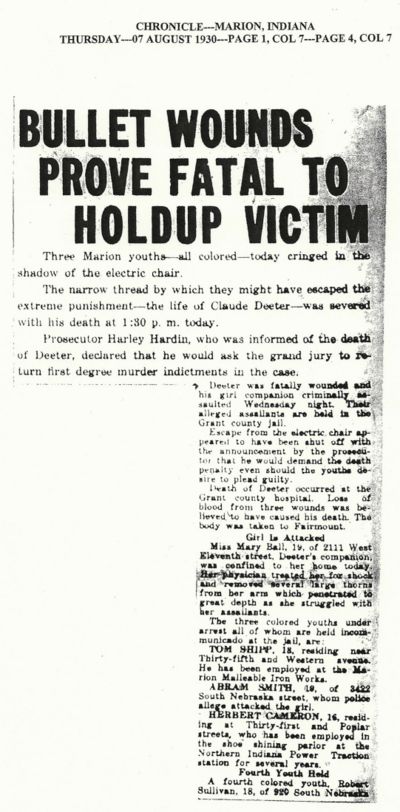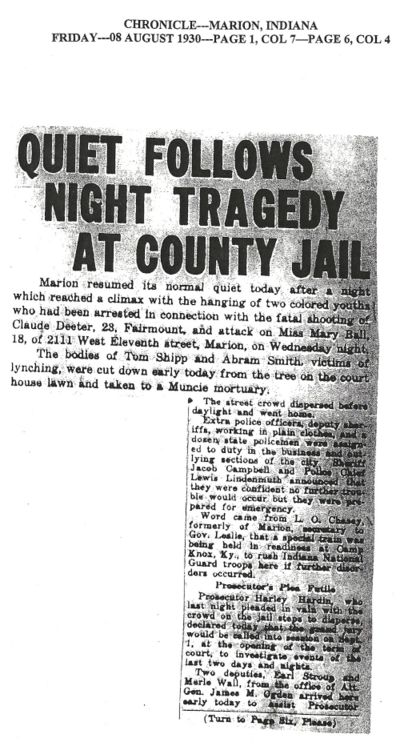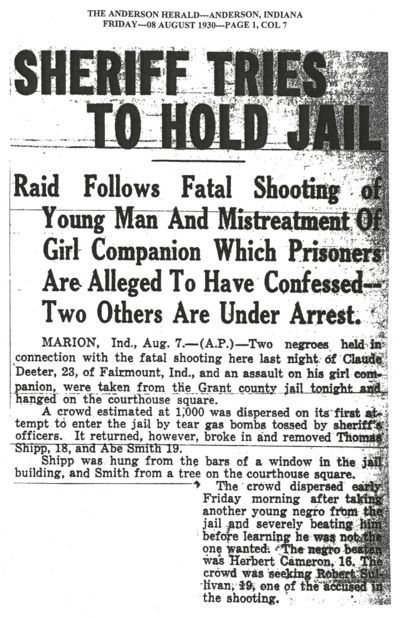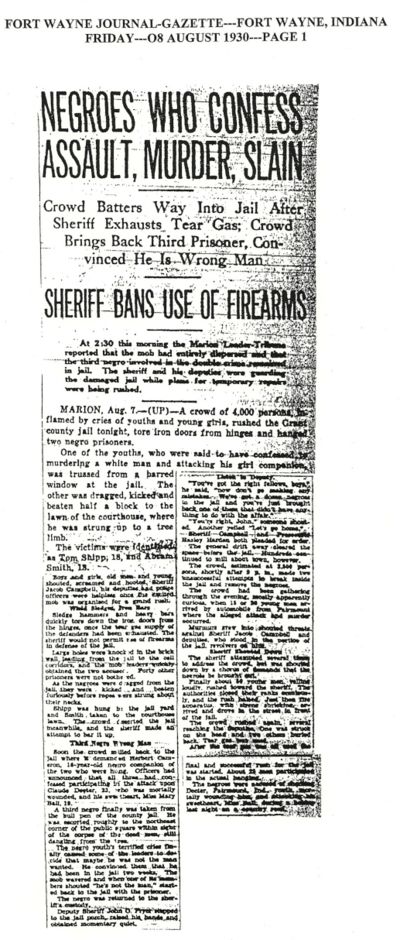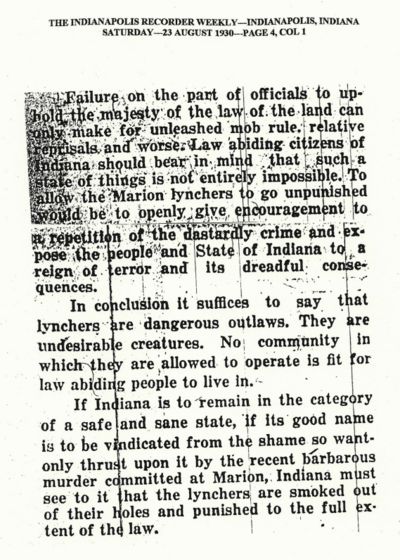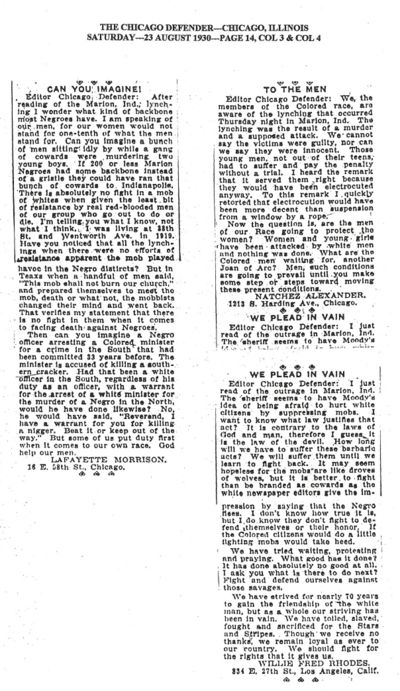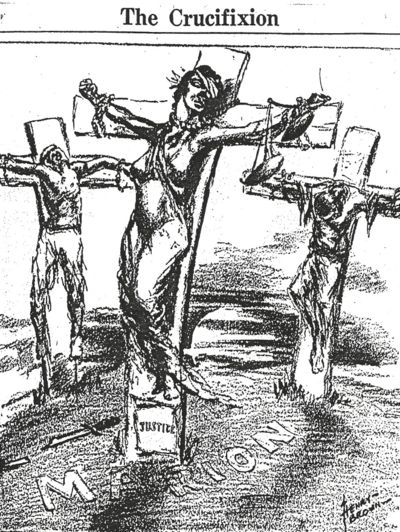Difference between revisions of "Lynching Newspapers"
12marymoreno (talk | contribs) |
12marymoreno (talk | contribs) |
||
| Line 40: | Line 40: | ||
This drawing is a representation of The Crucifixion and how there was no justice for the accused. Neither this drawing nor these articles would have been printed in Marion newspapers, this goes to show the differentiation of view points between different people and newspapers. | This drawing is a representation of The Crucifixion and how there was no justice for the accused. Neither this drawing nor these articles would have been printed in Marion newspapers, this goes to show the differentiation of view points between different people and newspapers. | ||
| + | |||
| + | ==Credits== | ||
| + | This page was put together by Mary Moreno | ||
Revision as of 06:01, 25 May 2011
In this project the goal was to show how the lynching was covered between the local and surrounding newspapers and the tragedy that unfolded from an attack on two innocent citizens of Marion, Indiana. Another goal is to show the different aspects and opinions between people, races, towns and states on such a sensitive and major event from Marion's history.
Contents
Marion Newspapers
In 1930 there were two newspapers in Marion,The Chronicle Tribune and The Leader Tribune. Below are two examples of what local newspapers had to say about the lynchings that occurred downtown.
This article from the Marion paper that was printed on August 7th, 1930 is about the murder of Claude Deeter and the attack of Mary Ball which occurred on that same day. It includes some information on the three youths that committed these crimes Shipp, Smith and Cameron such as their home addresses and jobs at the time.
"Marion resumed its normal quiet today after a night which reached a climax with the hanging of two colored youths.." Though this article acknowledges that the lynchings were tragedies, it also shows that the mob and the crowds of people that came downtown to witness the events had not many concerns after they had murdered Shipp and Smith. This reflects the mentality of the mob and other persons who deem this act just.
Nearby City Newspapers
Here are two newspaper articles, one from Anderson, Indiana and another from Fort Wayne,Indiana. The purpose of these examples are to show how this tragic event was covered in the cities surrounding Marion.
This article portrays the fact that the Sheriff and other officers tried to hold back the mob, though failing. The headline alone gives off the impression that every measure was taken to protect the accused. In actuality, all they did to prevent this was throwing cans of tear gas into the crowd as pointed out in this quote " A crowd estimated at 1,000 was dispersed on its first attempt to enter the jail by tear gas bombs tossed by sheriff's officers."
This article like others printed from Marion and surrounding cities focus on the attacks and how the Sheriff did all he could to defend the imprisoned."One of the youths was trussed from a barred window at the jail. The other was dragged, kicked and beaten half a block to the lawn of the courthouse, where he was strung up to a tree limb." This describes exactly how the crowd took justice into their own hands and murdered two of the accused.
Indianapolis and Chicago Black Newspapers
In some cities there were black newspapers. Two examples of these are the Indianapolis Recorder and the Chicago Defender.
“Lynchers are dangerous outlaws. They are undesirable creatures. No community in which they are allowed to operate is fit for law abiding people to live in.” This quote from the article above shows the drastic differences of feelings about the actions that took place and how disgusted the writers of this publication were with the actions of the mob. This black newspaper focuses mainly on the lynchings rather than the original crimes that took place. The other focus in this article is that the "lynchers are smoked out of their holes and punished to the full extent of the law."
"Those young men, not out of their teens, had to suffer and pay the penalty without a trial. I heard the remark that it served them right because they would have been electrocuted anyway. To this remark I quickly retorted that electrocution would have been more decent than suspension from a window by a rope."This shows the opposing thoughts of the events that one, the lynchers felt that they were achieving justice and two, others feeling it was completely unjust.
This drawing is a representation of The Crucifixion and how there was no justice for the accused. Neither this drawing nor these articles would have been printed in Marion newspapers, this goes to show the differentiation of view points between different people and newspapers.
Credits
This page was put together by Mary Moreno
